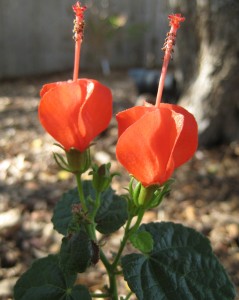Malvaviscus arboreus, commonly known as Turk’s cap, Turkscap, Turk’s Turban, Wax Mallow, Ladies Teardrop, Scotchman’s Purse, Bleeding hearts, or Mexican apple, is a member of the Malvaceae (Hibiscus) family. Malvaviscus is derived from a Greek word meaning “sticky mallow”, and arboreus, refers to the tree-like appearance of a mature plant.
It is a flowering perennial shrub, native to the Southeastern United States, Mexico, Central America, and South America that typically grows to 3-4’ in height, but can reach heights of up to 8-10’ with an equal spread. Its upper stems are green and fuzzy to the touch, while more woody towards its base. The leaves are roughly heart shaped and up to 5 inches in diameter, with rounded teeth around the edges. They are dark green, palmately veined, and velvety to the touch.
By far, the most outstanding feature of Malvaviscus arboreus are the one to two inch long scarlet flowers, similar to unopened Hibiscus blossoms, that adorn its stems. The flowers remain tightly wrapped, in an overlapping manner, around a central column, comprised of pistil and stamens, that extends an inch or more beyond the blossom like a small red licorice stick. The blooms appear mostly in the summer and fall attract butterflies, bees, and hummingbirds, and the small red fruit is edible to not only animals and birds, but humans as well. The fruit can be eaten raw or cooked, has a mealy texture, and has a taste similar to an apple.
Malvaviscus arboreus is adapted to Plant Hardiness Zones 7–12, and will grow in a variety of soils ranging from sandy to limestone. Once established, it is extremely heat and drought tolerant, and will grow in Full Sun to Partial Shade. It makes an excellent mass under-story planting beneath large trees with mature canopies. To ensure good flowering, prune back half of the previous season’s growth in early spring.
The leaves of the Malvaviscus arboreus have historically been used as an emmolient. A decoction, produced by first mashing, then boiling the flowers to extract oils and volatile organic chemicals, is used in Mexico to treat inflammation of the digestive tract and as a menstrual aid.
Plant some Malvaviscus arboreus in your yard this fall, USDA Plant Hardiness Zone permitting. You’ll be pleased with the plants adaptability and rewarded with a brilliant show of red blossoms next summer and fall.
Disclaimer
The traditional medicinal uses of Malvaviscus arboreus are listed purely for historical purposes. I am certainly not a doctor and make no claims as to their effectiveness in treating any illness or ailment. Always check with your doctor before taking any herbal supplements. Although many people still use this plant for the purposes listed, there are very specific ways that the plant must be processed and ingested or applied. In other words, do your due diligence. Don’t just grab a handful of red flowers from the nearest plant and eat them in hopes of settling your upset tummy.


